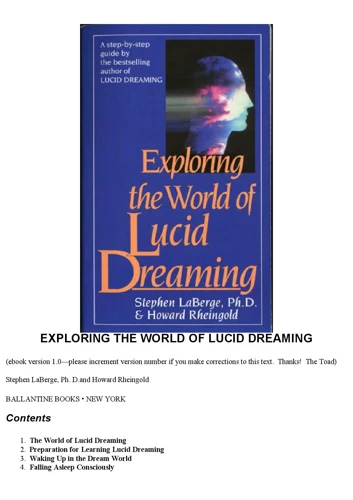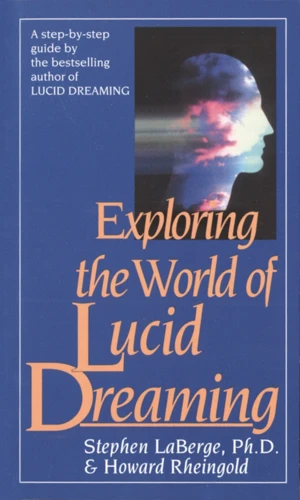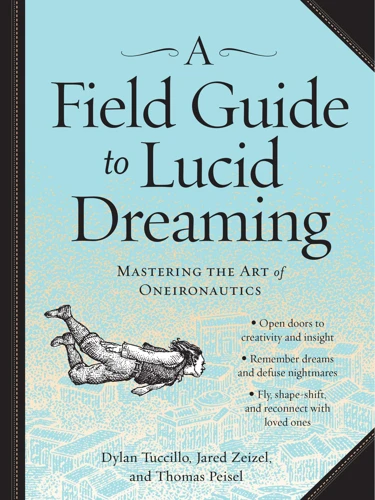Introduction: What is Lucid Dreaming?

Lucid dreaming is the state of being aware that you are dreaming while you are still in the dream. It is a unique state of consciousness where you can control your dreams and experience them as if they are real. You can fly, travel to different places, and even create your own dream world. It is like entering another dimension where the possibilities are endless.
This phenomenon has been a topic of interest for centuries, and many ancient cultures even believed that dreams held significance in the spiritual realm. However, it wasn’t until the 20th century that scientists began to study lucid dreaming and explore its potential benefits.
While some may dismiss lucid dreaming as a mere fantasy, research has shown that it has real effects on the brain and can nurture creativity and problem-solving skills. Many people have also reported having profound personal insights and experiencing a greater sense of well-being as a result of lucid dreaming.
There are various techniques that one can practice to induce lucid dreaming, and we will explore these later on in this article. Suffice it to say that it is a skill that can be learned and mastered with practice.
In essence, lucid dreaming unlocks the limitless potential of the human imagination and creates a world of endless possibilities. It is a phenomenon that continues to captivate and intrigue people from all walks of life.
Benefits of Lucid Dreaming

Exploring the possibilities of our own consciousness has always been a fascinating pursuit. Lucid dreaming, the ability to recognize and control our dreams, offers a unique opportunity to delve into our own subconsciousness and unlock its potential. The benefits of lucid dreaming are numerous and extend beyond just personal discovery. It can lead to a gateway of thrilling adventures waiting to be explored. Let’s dive deeper into why lucid dreaming is such an exciting and valuable skill to develop.
Beyond Personal Discovery
One of the most exciting aspects of lucid dreaming is its potential to go beyond personal discovery. While exploring one’s inner self and dreams can bring new insight and understanding, there is also the opportunity to use lucid dreams as a gateway to new and exciting experiences.
Through lucid dreaming experiences, many dreamers have traveled to other worlds and dimensions, met entities and beings, and had experiences that defy explanation. Some even claim to have had contact with extraterrestrial civilizations or to have tapped into collective consciousness.
Many spiritual practitioners and advocates of lucid dreaming believe that these experiences are real in some sense, and that they provide access to knowledge and insight that is difficult to obtain through waking life alone. Others view these experiences as symbolic representations of one’s inner world and psyche, and find them equally valuable as a way of exploring the self and the nature of human experience.
Regardless of how one interprets these experiences, there is no denying that lucid dreaming can offer a truly unique and fascinating adventure. For those who are willing to embrace the unknown, there is a vast universe of possibility waiting to be explored.
A Gateway to Travel and Adventure
Lucid dreaming goes beyond personal discovery and can serve as a gateway to travel and adventure. The ability to explore new and exciting places without leaving the comfort of your bed is awe-inspiring. It’s an experience that allows you to travel, not only to far-off destinations, but also to worlds that exist only in your imagination. Through lucid dreaming, the possibilities for adventure and exploration are limitless.
Here are some ways that lucid dreaming can serve as a gateway for travel and adventure:
- Visit exotic destinations: With lucid dreaming, you can “travel” to any place you can imagine. Whether it’s exploring the depths of the ocean or hiking through a dense jungle, your subconscious mind can create vivid and detailed landscapes that are as real as any waking experience.
- Experience different cultures: Through lucid dreaming, you can immerse yourself in new cultures and ways of life. Interact with the locals or attend festivals and events that only exist in your mind.
- Explore outer space: For those who dream of exploring the stars, lucid dreaming can provide a unique opportunity to experience space travel. Fly to distant planets, witness supernovas, and experience the vastness of the universe.
- Time travel: With lucid dreaming, you can travel through time and experience different eras, from ancient civilizations to future worlds.
- Create your own adventures: The beauty of lucid dreaming is that you have complete control over your dreams. You can create your own adventure, whether it’s going on a treasure hunt, solving a mystery or engaging in a thrilling action-packed scenario.
The best part? Lucid dreaming offers all of these incredible experiences without any limitations or boundaries. It’s a world where your imagination is your only limit. So, what are you waiting for? Start exploring the limitless possibilities of lucid dreaming and unlock a gateway to travel and adventure that you may have never thought possible.
The Science of Lucid Dreaming

As we delve deeper into the realm of lucid dreaming, it’s natural to wonder about the scientific mechanisms behind this phenomenon. The concept of conscious control within a dreaming state seems almost paradoxical, prompting us to ask: how exactly does this happen? To truly appreciate the power and potential of lucid dreaming, it’s important to understand the science behind it. Let’s take a closer look at the processes that occur during sleep and the triggers that lead to lucidity.
What Happens When We Sleep?
During sleep, our bodies and brains go through a series of complex processes. Here are some of the things that happen:
- Our breathing and heart rate slow down: During sleep, the body enters a state of relaxation where the heart rate and breathing slow down. This helps us conserve energy and feel rested when we wake up.
- Our brain waves change: As we move through different stages of sleep, our brain waves change. During deep sleep, our brain waves slow down, while during REM (Rapid Eye Movement) sleep, our brain waves become more active.
- The body repairs itself: While we sleep, our bodies release hormones that help repair and regenerate cells, tissues, and organs. This is important for our overall health and wellbeing.
- The brain processes information: Throughout the night, the brain processes the information that we’ve taken in during the day. This helps us consolidate memories, learn new things, and make connections in our brains.
- We dream: Dreams occur during the REM stage of sleep. While we may not always remember our dreams, they can be vivid and sometimes even lucid.
All of these processes are important for our health and wellbeing. However, when it comes to lucid dreaming, it’s the dreaming stage that is of particular interest. By becoming aware that we are dreaming while we are in a dream, we can unlock a world of limitless possibilities and adventures.
What Triggers Lucidity?
Lucidity in dreams can be triggered by various techniques and factors. Here are some common triggers:
| Trigger | Description |
|---|---|
| Reality checks | Performing regular reality checks during the day can train your mind to question reality more deeply, increasing the likelihood of doing the same in a dream. This involves questioning whether you are dreaming or awake by checking for unusual or inconsistent details. |
| Dream journals | Keeping a dream journal can help you identify patterns and recurring themes in your dreams, making it easier to recognize when you are dreaming. Writing down your dreams also improves your dream recall overall. |
| Intention setting | By setting a conscious intention to have a lucid dream before going to sleep, you are more likely to subconsciously recognize that you are dreaming while in the dream state. |
| Sensory stimuli | Some people find that certain sensory stimuli, such as flashing lights or a specific sound, can trigger lucidity in dreams. |
| Wake-Back-To-Bed (WBTB) | WBTB involves waking up after several hours of sleep, staying awake for a short period, and then going back to sleep with the intention of having a lucid dream. This technique takes advantage of the fact that REM sleep, where dreaming occurs, is more intense and frequent in the early morning hours after several hours of sleep. |
| Mnemonic Induction of Lucid Dreams (MILD) | MILD involves setting the intention to recognize that you are dreaming while in a dream, then repeating a mental phrase like “I’m going to recognize that I’m dreaming” while falling asleep. |
| Wake-Induced Lucid Dreams (WILD) | WILD involves maintaining consciousness while your body falls asleep. This requires a high level of concentration and can be difficult to achieve, but can lead directly into a lucid dream. |
It’s worth noting that not all techniques work for everyone, and it may take some trial and error to find what works best for you. Additionally, maintaining a regular sleep schedule and getting enough quality sleep can also increase the likelihood of having lucid dreams.
Practicing Lucid Dreaming: Reality Checks and Dream Journals

As you delve further into the world of lucid dreaming, you may begin to wonder how you can train yourself to become more aware of when you are dreaming. It can be a perplexing and daunting task, but fear not. By building awareness and forming habits through reality checks and dream journals, you can teach yourself to recognize the signs of dreaming and take control of your adventures in the dream world.
Building Awareness
Building awareness is a crucial step in practicing lucid dreaming. It involves training oneself to be more present and mindful, both in waking life and during dream states. Here are some methods for building awareness:
- Mindfulness meditation: This practice involves sitting quietly and focusing on the breath, observing one’s thoughts without judgment. It can help increase overall awareness and improve the ability to recognize when one is dreaming.
- Reality checks: These are brief mental or physical checks that one performs throughout the day to determine whether or not they are dreaming. For example, checking whether one can breathe through a closed nose or whether text on a page remains the same after looking away and back again. The goal is to develop a habit of questioning reality and increasing one’s critical awareness.
- Attention exercises: Simply practicing being more attentive in everyday life can also help build awareness for lucid dreaming. This involves actively engaging with one’s surroundings and paying attention to details that may often go unnoticed. For example, noticing the scent of a flower or the sound of a bird chirping.
By regularly practicing these techniques, one can gradually become more aware of their internal and external world. This heightened consciousness can translate to more frequent lucid dreams, as the mind becomes more accustomed to discerning between reality and dreams.
Forming Habits
When it comes to practicing lucid dreaming, it’s important to form habits that build awareness throughout the day. By incorporating various reality checks and establishing a dream journal, you can increase your chances of becoming lucid while dreaming. Here are some habits to consider adding to your daily routine:
- Mindfulness Meditation: Starting your day with a mindfulness meditation can help you become more aware of your thoughts and feelings. This heightened awareness can carry over into your dreams and make it easier to recognize that you’re dreaming.
- Reality Checks: Throughout the day, take time to ask yourself if you’re dreaming. Engage your five senses to explore your surroundings, even if you think you’re awake. This heightened awareness carries over into your dreams, making it more likely that you’ll recognize when you’re dreaming. You can also perform specific reality checks such as pinching your nose and trying to breathe through it, or trying to put your finger through your hand.
- Dream Journal: Keep a dream journal next to your bed and jot down any dreams you remember as soon as you wake up. Over time, you’ll start noticing patterns in your dreams and be better able to recognize when you’re experiencing a dream. This can also help you improve your dream recall, which is essential for lucid dreaming.
- Affirmations: Repeating a phrase or mantra several times throughout the day can also help build awareness. For example, you could repeat to yourself, “I will remember my dreams” or “I am aware of my surroundings.” This builds an intention in your mind that carries over into your dreams.
- Digital Detox: Limit your exposure to technology before bed. Blue light from electronic devices can interfere with the natural production of melatonin, which helps regulate sleep. By taking a break from screens before bed, you’ll also be more likely to remember your dreams.
By incorporating these habits into your daily routine, you’ll start building awareness and increase your chances of becoming lucid while dreaming. With patience and consistency, you can unlock the limitless possibilities of lucid dreaming and embark on the adventures of a lifetime.
Lucid Dreaming Techniques

For those who are interested in unlocking the limitless possibilities of lucid dreaming, there are various techniques that can be practiced. These techniques aim to trigger lucidity so that dreamers can control their dreams and embark on exciting adventures. But with so many different techniques to choose from, it can be overwhelming to decide which one to try first. Fear not, for we will delve into some of the most popular lucid dreaming techniques that can be used to access the depths of the unconscious mind. Let’s explore the techniques that can lead to incredible lucid dreaming experiences.
Wake-Back-to-Bed (WBTB)
One technique for inducing lucid dreams is the Wake-Back-to-Bed (WBTB) method. This method involves waking up from sleep after a few hours, staying awake for a brief period, and then going back to sleep. The purpose of the WBTB technique is to increase your chances of becoming aware that you’re dreaming by interrupting your sleep cycle and allowing you to enter REM sleep more quickly. Here are the steps to practicing the WBTB technique:
- Set an alarm: Set an alarm for 4 to 6 hours after you go to sleep.
- Wake up: When your alarm goes off, get out of bed and stay awake for 20-30 minutes. This will help to break up your sleep cycle and increase your awareness.
- Perform reality checks: During the 20-30 minute period, perform reality checks such as looking at your hands, counting your fingers, or checking the time. This will help you build your awareness and increase your chances of realizing you’re dreaming.
- Go back to bed: After the 20-30 minute period, go back to bed with the intention of having a lucid dream. Focus on your intention as you fall back to sleep.
By practicing the WBTB technique, you can increase your chances of becoming aware that you’re dreaming and ultimately have more lucid dreams. Remember to practice this technique consistently and with patience, as it may take some time to see results.
Mnemonic Induction of Lucid Dreams (MILD)
Mnemonic Induction of Lucid Dreams (MILD) is a technique for inducing lucid dreams that focuses on improving prospective memory, which is the ability to remember to do something in the future. This technique was developed by Dr. Stephen LaBerge, a pioneer in the scientific study of lucid dreaming.
How does MILD work?
The MILD technique involves setting intention before going to sleep, with the idea of increasing the likelihood of becoming lucid during the dream. The following steps demonstrate the process:
| Step 1: | Set an intention for lucid dreaming before going to sleep, using affirmations such as “I will remember to recognize that I’m dreaming” or “I will become lucid in my dreams” |
| Step 2: | Focus on a recent dream in which you were not lucid and imagine yourself becoming aware that you are dreaming. Review this visualization as you fall asleep. |
| Step 3: | Wake up after 4-5 hours of sleep, when dreams are most frequent and vivid. Recall the dream you were just having and visualize becoming lucid and taking control of the dream. |
| Step 4: | Repeat the affirmation and visualization until you fall back to sleep. |
By repeating the affirmation and visualization during the night, the technique increases the chances of becoming aware during the dream.
Does MILD work for everyone?
Like all lucid dreaming techniques, the effectiveness of MILD can vary depending on the individual. However, several studies have shown that MILD is one of the more successful techniques for inducing lucid dreams. It is particularly effective for individuals who are proficient in working with prospective memory and can remember to do something in the future.
Final thoughts on MILD
Mnemonic Induction of Lucid Dreams is a technique that requires practice and persistence. It may not work for everyone, but for those who are willing to put in the effort, it can be an effective way to increase the frequency of lucid dreams. MILD is not a shortcut to lucid dreaming, but rather a tool to improve your chances of experiencing the phenomenon.
Wake-Induced Lucid Dreams (WILD)
One of the most powerful techniques for inducing lucid dreams is the Wake-Induced Lucid Dream, or WILD. This technique involves staying awake while your body falls asleep. Although it is one of the more difficult techniques to master, the potential rewards of WILD make it well worth the effort.
To achieve a WILD, you need to first find a comfortable position in bed and focus on relaxing your body. As you start to feel yourself drifting off to sleep, keep your mind focused and alert. You may notice that you start to experience some strange sensations, such as seeing flashes of light or feeling a sense of weightlessness. These are typically signs that you are on the verge of slipping into a dream state.
Table: Steps for Practicing WILD
| Step 1: | Lie down in a comfortable position and relax your body. |
| Step 2: | Focus on staying in a state of heightened awareness as your body falls asleep. |
| Step 3: | Pay attention to any hypnagogic imagery, sounds, or sensations. |
| Step 4: | Visualize yourself entering a dream state while maintaining your awareness. |
| Step 5: | Stay calm and let the dream form around you while staying aware. |
With practice, you will be able to maintain your awareness as your body drifts off to sleep, and you will find yourself slipping effortlessly into a lucid dream state. WILD can be one of the most powerful techniques for exploring the limitless possibilities of lucid dreaming.
Traveling in Your Dreams: Lucid Dreaming Destinations

Have you ever wished you could travel to far-off destinations without the hassle of packing, booking flights, and dealing with crowds? With lucid dreaming, the world is your oyster. Whether you want to explore the depths of the ocean or soar high in the sky, your own mind can take you there. In this section, we’ll dive into the limitless possibilities of lucid dreaming destinations and the wonders you can discover within the confines of your own subconscious. Get ready to set off on an adventure like no other.
The Possibilities Are Endless
When it comes to lucid dreaming destinations, the possibilities truly are endless. Whether you want to explore the depths of the ocean, venture into outer space, or even visit a fictional world, your dreams can take you there. Here are just a few examples of the many destinations you can visit in your lucid dreams:
| The Beach | Go for a swim in crystal clear waters or relax on the warm sand. You can even try your hand at surfing or other water sports without the limitations of the physical world. |
| The City | Explore bustling city streets, towering skyscrapers, and famous landmarks. You can even create your own city and watch it come to life. |
| The Forest | Take a hike through lush green forests, discover hidden waterfalls, and observe exotic wildlife. You could even try your hand at camping or survival skills. |
| Outer Space | Blast off into the galaxy and explore the mysteries of space. Visit other planets, meet extraterrestrial life, and witness spectacular views of the universe. |
| The Past | Travel through time and experience different eras, from ancient civilizations to medieval times. You can even interact with historical figures or witness pivotal moments in history. |
| The Future | Take a glimpse into what the future may hold, from utopian societies to post-apocalyptic worlds. You can even create your own futuristic world and watch it unfold. |
Remember, these are just a few examples – the possibilities truly are endless. With lucid dreaming, you have the power to explore and create your own dream worlds, limited only by your imagination.
Lucid Dreaming Destinations to Visit
When it comes to lucid dreaming destinations, the possibilities are truly endless. In this article, we will explore some of the most popular and fascinating scenarios to experience in your dreams. Take a look at the table below for some ideas:
| Destination | Description |
|---|---|
| The Beach | Experience warm sand and crystal clear water without having to leave your bedroom. Practice surfing or swimming with dolphins. |
| The Mountains | Explore snow-capped peaks and hike through misty forests. Try skiing or snowboarding down steep slopes. |
| Deep Space | Travel to far-off galaxies and witness stunning celestial events like meteor showers and supernovas. Meet intelligent life forms from other worlds. |
| The City | Experience the energy and excitement of a bustling metropolis. Walk through neon-lit streets and attend amazing events like concerts and parties. |
| The Underwater World | Swim with exotic sea creatures and explore coral reefs and shipwrecks. Take a submarine tour of the deep sea. |
| The Jungle | Get lost in a lush tropical rainforest and discover hidden waterfalls and ancient ruins. Meet jungle animals like monkeys and parrots. |
These lucid dreaming destinations are just a few examples of the incredible experiences you can have in your dreams. Remember, the only limit is your imagination. With practice and dedication, you can unlock the limitless possibilities of lucid dreaming and travel to worlds beyond your wildest dreams.
Creating Adventure in Your Dreams: Lucid Dreaming Activities

Exploring the depths of the subconscious mind is not only an opportunity to discover oneself, but it is also a chance to have experiences beyond the bounds of reality. In a lucid dream, any activity or adventure is possible, limited only by imagination. However, for many beginners, it may be challenging to come up with ideas on how to make the most of their lucid dreaming experiences. In this section, we will explore various activities and adventures that can be undertaken in lucid dreams, from the outdoors and extreme sports to creative pursuits and socializing. So let’s dive into the limitless possibilities of lucid dreaming and create our dream adventures.
Adventure Sports and Outdoor Activities
One of the most exciting ways to explore the world of lucid dreaming is by engaging in adventure sports and outdoor activities. The possibilities are endless, and the only limit is your imagination. With lucid dreaming, you have the power to experience extreme sports and outdoor adventures in a completely safe, controlled environment.
Activity | Description
Skydiving | Feel the adrenaline rush of jumping out of a plane and soaring through the sky without the fear of falling.
Surfing | Ride the waves and experience the thrill of catching the perfect wave without the risk of wiping out.
Mountain Climbing | Scale the world’s tallest mountains and take in breathtaking views from the summit.
Skiing/Snowboarding | Shred down snow-covered mountains without having to worry about icy conditions or avalanches.
Scuba Diving | Dive into the depths of the ocean and explore coral reefs and exotic marine life without needing expensive equipment or certifications.
Rock Climbing | Climb sheer rock faces and push your limits without the risk of falls or injury.
Hiking | Trek through beautiful landscapes and enjoy the tranquility of nature without fatigue or harsh weather conditions.
Camping | Camp under the stars and experience the great outdoors from the comfort of your own mind.
As with any lucid dream, it’s important to properly prepare and stabilize the dream once you’ve achieved lucidity. Engaging in adventure sports and outdoor activities can be particularly stimulating, so it’s important to take time to focus your mind and remain aware of your surroundings. By taking the time to properly prepare and stabilize your lucid dream, you can fully immerse yourself in the adventure and come away with memories that will last a lifetime.
Creative Pursuits and Self-Discovery
When it comes to creative pursuits and self-discovery in lucid dreaming, the possibilities are truly endless. This is where you can tap into your subconscious mind and explore your inner creativity and deepest desires.
Here are a few activities to try in your next lucid dream:
- Painting and Drawing: Utilize the dream world to create beautiful works of art without any limitations. Choose any medium you desire and let your imagination run wild.
- Writing: Use your lucid dream as a creative writing space, allowing your subconscious to lead the way and spark new ideas.
- Music: Play an instrument, compose a song, or even attend a concert featuring your favorite artists.
- Dancing: Get lost in the music and let your body move freely, expressing yourself in new and creative ways.
- Exploring Your Inner Self: Use your lucid dream as a space for self-discovery, with the opportunity to meet your inner self, explore your emotions, and gain a deeper understanding of your psyche.
Lucid dreaming can also be used as a tool for problem-solving and decision-making. Use your dreams as a space to work through difficult situations or to gain insight into a particular problem.
Remember that in the world of lucid dreaming, the only limit is your own imagination. So, get creative and see where your dreams can take you!
Socializing and Meeting New People
Lucid dreaming provides the unique opportunity to interact with people in a completely different world – your subconscious mind. If you’re looking to meet new people, socialize or expand your social circle, lucid dreaming can be an excellent tool. Here are some ideas for social activities you can try in your lucid dreams:
- Attend a party: In your next lucid dream, attend a party and engage with other dream characters. You can have fun dancing, playing games, and even striking up conversations with people you’ve never met before.
- Visit a new city: Explore a new city in your dreams and immerse yourself in the culture. You may even find yourself interacting with locals and making new friends.
- Join a club: Want to try a new hobby or activity? Join a club in your lucid dream where you can interact with like-minded individuals and learn new skills.
- Go on a date: If you’re single and looking to meet someone special, lucid dreaming can provide the perfect opportunity. Create your dream partner or find a dream character who catches your eye and take them on a romantic date.
- Attend a concert: Imagine attending your favorite artist’s concert, surrounded by other fans. You can sing along, dance, and even strike up conversations with fellow concert-goers.
Remember, the key to making the most of socializing in lucid dreams is to engage and interact with the dream characters around you as if they were real people. Be present in the moment and enjoy the experience!
Dealing with Challenges in Lucid Dreaming
As exciting as the possibilities of lucid dreaming may be, there can also be obstacles to overcome. When exploring the depths of our subconscious minds, we may encounter unexpected challenges, such as dream destabilization or frightening nightmares. It is important to approach these experiences with a level head and a toolbox of techniques to help navigate through them. In this section, we will delve into some helpful strategies for dealing with obstacles in lucid dreaming.
Stabilization Techniques
When lucid dreaming, it can be all too easy to wake up prematurely or lose control of the dream. This is why it is important to practice stabilization techniques to help maintain the lucid state. Below are some effective stabilization techniques to assist you in retaining control and prolonging the experience:
- Touching: Engaging the sense of touch can provide a sense of grounding in the dream world. Rubbing your hands together or touching a nearby object can help you maintain lucidity.
- Spinning: As strange as it may seem, spinning your body around in the dream world can help you maintain lucidity. It serves to reset the dream and stabilize the experience.
- Focusing: Concentrating on a single object or focusing on your surroundings can help to cement your lucidity within the dream.
- Maintaining Calm: Anxiety and excitement can cause a lucid dream to end abruptly. It is essential to remain calm and level-headed while in the dream world.
- Verbal Affirmations: Repeatedly affirming your lucid state by saying things like, “I’m lucid dreaming” can help solidify the dream and increase control.
By using these stabilization techniques, you can enjoy longer and more vivid lucid dream experiences. It may take some practice to master these techniques, but the effort is well worth it for the adventure and exploration that awaits in your own imagination.
Overcoming Fear and Nightmares
Experiencing fear and nightmares during lucid dreaming can be a common occurrence since the dream state can intensify our emotions. However, overcoming these negative experiences is possible with a few helpful techniques.
-
Confront the Fear:
One effective approach is to face the fear head-on by directly confronting it. This may include summoning a friendly character or superhero to help you feel safe and courageous. -
Change the Narrative:
Another technique involves changing the storyline of the dream by using your conscious awareness. For example, if you are being chased by a monster, you can pause the dream and switch the setting to a peaceful environment. -
Use Affirmations:
Affirmations can also be helpful in reducing fear and promoting positivity during lucid dreams. Repeating a phrase like “I am safe and protected” can help you feel more in control and secure in the dream world. -
Breathing Techniques:
Applying breathing exercises such as deep inhales and exhales can calm your nervous system and reduce fear responses even though you are dreaming. -
Avoid Triggers:
Lastly, it is important to avoid any triggers that may cause fear or anxiety in your waking life. It could be a good idea to refrain from watching horror movies or consuming alcohol before sleeping, which can influence the tone of your dreams.
By implementing one or more of these techniques, you can successfully overcome fear and nightmares in lucid dreams and enjoy your adventures even more.
Conclusion: The World is Yours to Explore
The world of lucid dreaming offers limitless possibilities for adventure and personal growth. With dedication and practice, anyone can unlock the ability to control and explore their own dreams.
Through lucid dreaming, individuals can tap into their subconscious mind and gain a deeper understanding of their thoughts, emotions, and desires. This self-discovery can lead to improved mental and emotional health in waking life.
But lucid dreaming is not just a tool for introspection. It can also be a gateway to exciting and exotic travel experiences, allowing individuals to visit places that may not be accessible in the waking world. The possibilities for adventure are truly endless.
Of course, achieving lucid dreaming takes practice and perseverance. Building awareness, forming habits, and trying different techniques are all key to unlocking the potential of lucid dreaming. With time and effort, anyone can master this skill and explore the world of their dreams.
Of course, challenges can arise in lucid dreaming, such as instability and nightmares. But with the right techniques and mindset, these obstacles can be overcome and even transformed into opportunities for growth and self-improvement.
In the end, lucid dreaming is a rich and fascinating topic that offers something for everyone. Whether you’re seeking personal growth, exotic adventures, or simply a new hobby, the world of lucid dreaming is waiting for you to explore. So take the leap and unlock the limitless possibilities of your own dreams today.
Frequently Asked Questions
What is the difference between a regular dream and a lucid dream?
In a regular dream, you are not aware that you are dreaming and cannot control the outcome of the dream. In a lucid dream, you are consciously aware that you are dreaming and can control the narrative of the dream.
Can anyone learn how to lucid dream?
Yes, with practice and patience, anyone can learn how to lucid dream.
What are some of the benefits of lucid dreaming?
Lucid dreaming can lead to personal discovery and growth, and can also be an exciting way to explore new destinations and activities in your sleep.
What is the science behind lucid dreaming?
The science behind lucid dreaming is still not fully understood, but it is believed to involve the prefrontal cortex of the brain, which is responsible for decision-making and self-awareness.
How can reality checks help with lucid dreaming?
Reality checks involve questioning your surroundings in real life to determine if you are dreaming or not. This habit can carry over into your dreams and help you become more aware.
What is a dream journal and how can it aid in lucid dreaming?
A dream journal is a notebook where you record your dreams in detail. Reviewing your journal can help you identify patterns and dream signs, which can lead to easier lucidity in future dreams.
What is the Wake-Back-to-Bed technique for lucid dreaming?
The Wake-Back-to-Bed technique involves waking up after a few hours of sleep, staying awake for a short period of time, and then going back to sleep with the intention of inducing a lucid dream.
What is the MILD technique for lucid dreaming?
The Mnemonic Induction of Lucid Dreams technique involves repeating a phrase or mantra in your mind before sleep, with the intention of remembering that you are dreaming when you have one.
What is the WILD technique for lucid dreaming?
The Wake-Induced Lucid Dreaming technique involves staying awake while your body falls asleep, with the intention of having a lucid dream.
How can you overcome fear and nightmares while lucid dreaming?
Techniques such as grounding yourself in the present moment and changing the narrative of the dream can help overcome fears and nightmares while lucid dreaming.








